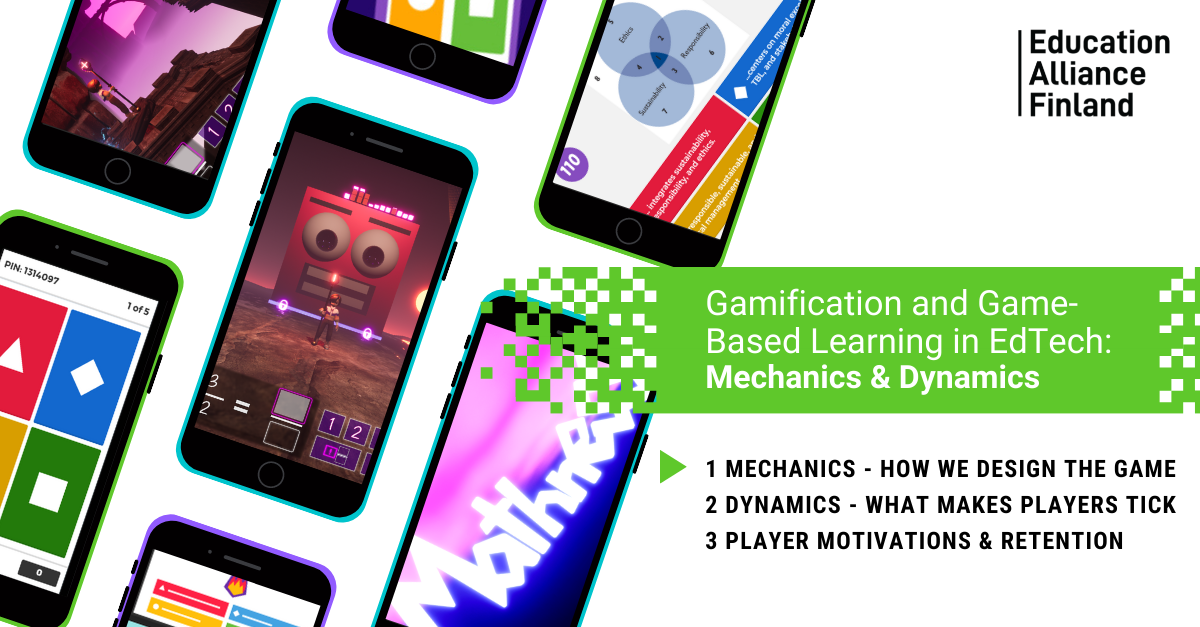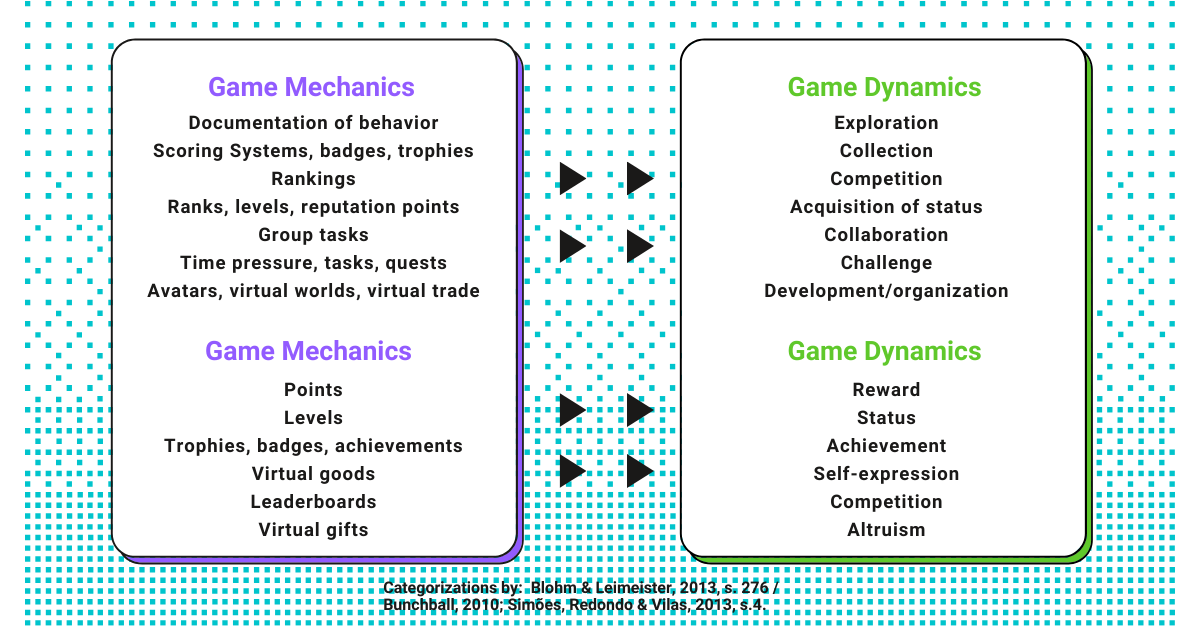Gamification & Game-Based Learning in EdTech: Mechanics and Dynamics
January 18, 2022

Number one reason for the huge popularity of educational games and gamifying educational solutions is likely to be the entertainment factor; well-designed game mechanics greatly increase student motivation and engagement.
Designing Digitally, a company that creates gamified solutions for corporate training, remarks that game mechanics should be carefully aligned with your specific learning goals. We also touched this topic in our previous gamification article, so be sure to check it out.
Besides matching the game mechanics with your learning goals, educational game designers should also consider: how can we motivate students to continue playing our game outside of school? The game industry is currently all about “games-as-a-service” (GaaS) business strategy - which relies on long-term retention and viewing gaming as a hobby (Koster 2019), and there are certain mechanics that are known to drive player engagement.
In today’s article we’ll share more about game mechanics and dynamics; how do they differ from each other and affect the players’ actions and motivations - and why it is meaningful to consider them separate.
Game Mechanics = How We Design the Game Environment
The MDA framework sees game design as interplay between game mechanics, dynamics and aesthetics (LeBlanc et al, 2004). Game mechanics are the underlying rules of the game, which produce the game dynamic: what happens, when these exact rules are played.
Game mechanics can be seen as the “building blocks” of gamification, whereas game dynamics correspond to specific user motives (Blohm & Leimeister 2013, 276).
So for example trophies, points, levels, leaderboards, group tasks and avatars fall under the category of game mechanics. While e.g. achievements, rewards, status, competition, collaboration or development are dynamics that can result from those mechanics.
Bunchball (2010, 2-9) clarifies this by defining game mechanics as the actions, behaviors and control mechanics used to gamify an activity - and game dynamics are the desires and motivations that compel those actions.
Therefore, if you’re aiming for a certain dynamic within the game – let’s say competition between students – adding the mechanic of rankings usually initiates a feeling of rivalry between the players.

Game Dynamics = What Makes Players Feel Motivated or Drives Certain Behaviors
”Game dynamics define the patterns of how the game and the players will evolve over some time. Not all learners are driven by the same elements.” -Designing Digitally
According to the MDA model, dynamics ”create aesthetic experiences”, and that they are the emergent behavior that arises from gameplay, when the mechanics are put into use. When designing the rules and mechanics in your game, consider what kind of dynamic situations can result from them. By developing models for predicting gameplay dynamics, it’s possible to avoid problems in the design. (LeBlanc et al., 2004.)
For example, rewards and leveling up mechanics often create a feeling of progression. However, too quick advancement within the game can lead to the player or learner losing interest because of the lack of proper challenge. Fixing this dynamic (acquisition of status) requires measuring and trialling what is the right time for the individual to advance.
It should be also kept in mind that some players may prefer a more competitive dynamic, while others enjoy different activities, like collaboration in groups or strategic problem solving; and these dynamics can alter in the game.
Example: When playing Kahoot! quizzes, the game mechanics dictate that the player will be given points only for the correct answers, and the faster they answer, the more points they get. This plays into two specific dynamics: challenge and risk vs. reward. Because of a small risk taking - should I answer quickly or think this through - the competition between players (which is driven by displaying the leaderboard after each question) feels more playful and casual. Whereas, slow-paced, knowledge testing quizzing creates a more serious aesthetic experience.
Mathness, an explorative platform game (currently in-development), has a more calm and soothing dynamic. Since there are no time restrictions, co-players or achievements - other than advancement within the game world - the learner can take their time solving math problems, developing and proceeding at their own pace. From these mechanics and dynamics, you can see Mathness is especially targeted to those that suffer from math anxiety; and learn better via stories, visual stimulation and individual goal setting.
The Benefits of Thought-out Game Mechanics and Dynamics
As mentioned before, well-tailored game mechanics and dynamics increase student motivation and engagement. There are several dynamics that create meaningful game experiences; Designing Digitally mentions hands-on learning activities, immediate feedback, freedom of choice and in-game simulations that reflect real-life as key reasons why gamification as a learning approach is so celebrated.
Dynamics usually have their basis in psychological needs. Proulx et al. remark in their article (2017) that in order for an educational game to increase the player’s motivation, four requirements need to be fulfilled: the students’ own goals, feelings of autonomy, competence and relatedness - the three latest being the foundational psychological needs recognized in Self-Determination Theory (SDT), a theoretical framework often utilized in the study of motivation and engagement.
To summarize: game mechanics are the building blocks of gamifying any product (levels, rankings, badges, quest, points etc.), while game dynamics affect players’ motivation and actions (status, altruism, reward, self-expression etc.).
Game mechanics are basically rules of the game, which produce certain game dynamics - and since these dynamics have a basis on people’s psychological needs, it’s important to consider what type of motivations, actions and experiences you’re hoping to generate with the gamified learning product.
From the very beginning of the design process, it’s crucial to think about:
What are my product’s key learning goals? >> They affect the selection of mechanics.
What individual goals or social aspects motivate my target groups? >> They most likely influence which dynamics matter the most inside the game.
And finally, how can I prove whether the game mechanics and dynamics are working the way they’re supposed to? When learners are engaging with them, do they produce the wanted aesthetic experiences that drive motivation and wanted experiences, or not?
Next up, more about retention!
References
Blohm, I., & Leimeister, J. M. (2013). Design of IT-Based Enhancing Services for Motivational Support and Behavioral Change.
Bunchball, I. (2010). Gamification 101: An introduction to the use of game dynamics to influence behavior. White paper, 9.
Hunicke, R., LeBlanc, M., & Zubek, R. (2004). MDA: A formal approach to game design and game research. In Proceedings of the AAAI Workshop on Challenges in Game AI (Vol. 4, No. 1, p. 1722).
